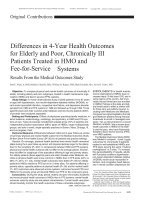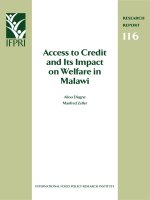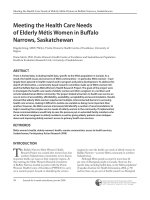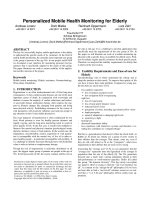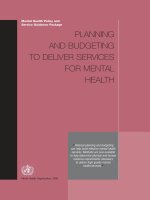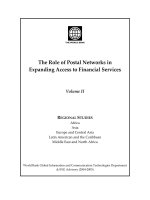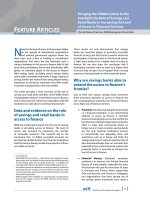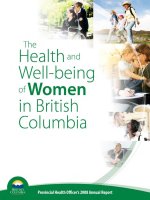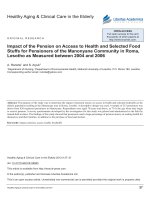ACCESS TO HEALTH SERVICES FOR ELDERLY MÉTIS WOMEN IN BUFFALO NARROWS, SASKATCHEWAN potx
Bạn đang xem bản rút gọn của tài liệu. Xem và tải ngay bản đầy đủ của tài liệu tại đây (425.61 KB, 44 trang )
ACCESS TO HEALTH SERVICES
FOR ELDERLY MÉTIS WOMEN IN
BUFFALO NARROWS, SASKATCHEWAN
Brigette Krieg
Diane J. F. Martz
Lisa McCallum
Revised August 2007
Project #146
ACCESS TO HEALTH SERVICES
FOR ELDERLY MÉTIS WOMEN IN
BUFFALO NARROWS, SASKATCHEWAN
Brigette Krieg
Diane J. F. Martz
Lisa McCallum
Originally published May 2007
Revised August 2007
Prairie Women’s Health Centre of Excellence (PWHCE) is one of the Centres of
Excellence for Women’s Health, funded by the Women’s Health Contribution Program
of Health Canada. The PWHCE supports new knowledge and research on women’s
health issues; and provides policy advice, analysis and information to governments,
health organizations and non-governmental organizations. The views expressed herein do
not necessarily represent the official policy of the PWHCE or Health Canada.
The Prairie Women’s Health Centre of Excellence
56 The Promenade
Winnipeg, Manitoba R3B 3H9
Telephone (204) 982-6630 Fax (204) 982-6637
This report is also available on our website:
www.pwhce.ca
This is project #146 of the Prairie Women’s Health Centre of Excellence
ISBN # 978-1-897250-16-7
ACCESS TO HEALTH SERVICES
FOR ELDERLY MÉTIS WOMEN IN
BUFFALO NARROWS, SASKATCHEWAN
Brigette Krieg
Diane J. F. Martz
Lisa McCallum
Revised August 2007
TABLE OF CONTENTS
Executive Summary 1
Introduction 3
Literature Review 5
A. Métis Identity 6
B. Access To Health Care Services 8
C. Informal Caregiving 13
D. Conclusion 14
Methodology 15
Participants 16
Limitations 16
Results 17
A. Existing Services 17
B. Client Issues 18
C. Current Barriers 19
D. Service Needs 24
Discussion 29
References 31
Appendix A 35
Appendix B 37
Appendix C 38
Access to Health Services for Elderly Métis Women in Buffalo Narrows, Saskatchewan
1
EXECUTIVE SUMMARY
The Northwest Métis Women’s Health Research Project investigated the health care
needs of elderly women and their caregivers in the Métis community of Buffalo
Narrows, Saskatchewan. The research project looked at access to home care and long-
term care services for elderly women in the particular demographic, social, cultural and
economic context of northern Métis communities. The goal of the project was to
recommend appropriate home care and long term care policies for northern Métis
communities and to ensure that these policies will be responsive to women’s needs as
care recipients, care providers and caregivers. By looking at the specific needs of
women, the research project hoped to raise awareness of gender as an important factor to
consider in developing and implementing policies related to care of the elderly.
This project used Pechansky and Thomas’ (1981) approach which describes the degree
of fit between clients and health system service access in terms of accessibility,
affordability, availability, acceptability and accommodation. However, it is important to
note that many of the issues that influence one dimension of access may also influence
another. With multiple, intersecting barriers to access for this population, addressing
needs becomes a challenge in prioritizing these dimensions alongside the health and
social issues unique to senior Métis women and their caregivers.
The project was led by a Métis Women’s Research Committee from the community of
Buffalo Narrows working in partnership with the Aboriginal women’s health research
coordinator of the Prairie Women’s Health Centre of Excellence (PWHCE). The
research used qualitative methods to gather information from Métis women about the
need for and access to home care and long term care services for elderly women in the
community. During individual interviews local Métis women were asked to describe the
types of services available, types of services needed, the quality of services available and
what was needed to improve the quality of services. They were asked to identify
barriers which limit access to services and to suggest ways those barriers might be
overcome. Based on the interviews, the Métis Women’s Research Committee developed
recommendations for ways to improve policies and programs to make them more
responsive to women’s health needs.
Responses from the Métis women in Buffalo Narrows identified many key
recommendations for meeting the complex service needs of elderly women in the
community and for improving access to health care and community services that would
ease the burden on extended family members and give elderly patients more
independence. Recommendations focused on addressing barriers to service access in
terms of accessibility, affordability, availability, acceptability and accommodation.
Access to Health Services for Elderly Métis Women in Buffalo Narrows, Saskatchewan
2
Access to Health Services for Elderly Métis Women in Buffalo Narrows, Saskatchewan
3
INTRODUCTION
The Northwest Métis Women’s Health Research Project investigated the health care
needs of elderly women in the Métis community of Buffalo Narrows, Saskatchewan.
These are important issues for women of all ages in rural and remote communities as
women shoulder the primary responsibility for providing care to young and old, sick and
disabled. Older women are both the recipients of care as well as care givers, while
younger women are most often care givers. The goal of the project was to recommend
appropriate home care and long term care policies for northern Métis communities and
to ensure that these policies will be responsive to women’s needs as care recipients, care
providers (paid) and caregivers (unpaid). By looking at the specific needs of women, the
research project hoped to raise awareness of gender as an important factor to consider in
developing and implementing policies related to care of the elderly.
Aboriginal peoples are interested in research rationales and processes and want
collaborative efforts that benefit the community and produce an accurate understanding
of the community and its issues (Leeman, et al, 2002; Smylie, 2001). At the Métis
Nation Health Policy Forum held in Saskatoon in April, 2002, one speaker commented
on the need for Métis to be “researched to life” through research that was Métis
generated and Métis controlled (Métis Centre, 2002). Research involving Aboriginal
communities around identified community issues should be conducted cooperatively and
collaboratively to ensure that the research needs of the community are indeed met.
The Buffalo Narrows Métis Women’s Health Research Project was led by a Métis
Women’s Research Committee with members from the community of Buffalo Narrows
working in partnership with the Aboriginal women’s health research coordinator of the
Prairie Women’s Health Centre of Excellence (PWHCE). The Métis Women’s Research
Committee made a decision to focus on services to elderly women in Buffalo Narrows as
an important issue for the community. In community discussions held in the spring of
2004, women identified the following components to the issues:
1. Fiscal restraint, health care restructuring and limited investment in home care
infrastructure may save the health system money, but at the expense of both patients
and caregivers;
2. Concerns that family members are expected to provide home care support as an
extension of their domestic and family work;
3. A realization that when one member of a family requires care, the stress of
caregiving affects everyone in the family, but that women and men recognize and
respond to stress differently; and
4. There is a lack of good quality long-term care available in the community of Buffalo
Narrows to take the place of existing informal care giving.
Access to Health Services for Elderly Métis Women in Buffalo Narrows, Saskatchewan
4
The Métis community of Buffalo Narrows and surrounding communities do not have
long-term care facilities for the elderly. Therefore elderly people in need of care must
move to a long term care facility outside of the community, taking them away from their
home and family members. The closest long term care facility is in Meadow Lake, two
and one-half-hours’ drive from Buffalo Narrows. Not all families have transportation or
the financial resources to visit their elderly family members who have been sent out of
the community for remainder of their lives (see map).
Elderly residents who live in their
homes in the community of
Buffalo Narrows do have access
to home care. Available services
include home nursing,
homemaking, Meals on Wheels
and day programs. Homemaking
and Meals on Wheels are offered
to clients at a fee of $2.50 per
hour. People also have
community access to outreach
workers, mental health workers,
addictions workers, nutrition
programs, a dietitian and a
diabetes educator through the
Keewatin Yatthé Regional Health
Authority (www.kyrha.ca, 2006).
Crosato and Leipert (2006) report
that a lack of services and funding
has resulted in informal care
being more prevalent in rural and
remote areas. While Statistics
Canada reports that over 18% of the Canadian population over the age of 15 years
provided care for an elderly person, in the community of Buffalo Narrows 28.5% of the
population reported they provided care for an elderly person. Sixty percent of those
providing care for the elderly in Buffalo Narrows were women (Statistics Canada
2001b).
Access to Health Services for Elderly Métis Women in Buffalo Narrows, Saskatchewan
5
LITERATURE REVIEW
The Canadian Institute for Health Information report Improving the Health of Canadians
states “there are few specific data, including health data, on the Métis population” (CIHI
2004; 78). The report goes on to comment that “given the divergent histories and
experiences of Canada’s Aboriginal Peoples, First Nations data alone do not provide an
adequate indicator of the health status of all three recognized Aboriginal groups” (CIHI
2004; 97). Although Métis people account for more than 26% of Aboriginal people in
Canada, Young (2003), in a recent survey of the leading academic health journals, noted
that less than 1% of health research on Aboriginal populations focused on Métis people.
As a result, the health issues and concerns of Métis communities have not been well
documented.
Current literature on the health care needs of elderly Métis women residing in Northern
and remote locations is even more limited. Examination of recent literature using the
key words: health care; rural; remote and northern; Métis; Aboriginal; elderly; aged;
informal care and health services highlighted the lack of research on these topics. A
review of available journal articles and reports resulted in little current information on
the issues surrounding access to health care services, the health needs of elderly Métis
women, the health needs of rural and remote residents or the provision of informal care
services. This lack of information exists despite acknowledgement of the health needs
and the unique barriers to health care services in Canada’s rural and remote communities
(Romanow, 2002).
The increase in elderly peoples in Canada and the inability of current health and social
policy to meet their service needs and demands has placed this population in jeopardy
(Buchignani & Armstrong-Esther, 1999). In Canada, 17% percent of seniors live below
the poverty line (Saskatchewan Seniors Mechanism [SSM], 2003) and these numbers
appear to be directly related to age, gender and geography. That is, the annual income
for seniors residing in large urban centers was $16,521 compared to $16,407 in small
urban centers, and $13,311 in rural areas. Further among those aged 75+, 11% of
females and 9% of males reported annual incomes less than $10,000 and 75% of females
and 58% of males reported incomes less than $20,000 per annum (SSM, 2003). In
Saskatchewan, women make up 50% of seniors aged 70-74. However, by ages 75-79,
women comprise 57% of seniors and account for 64% of all Saskatchewan seniors 80
years and older (Statistics Canada, 2001a).
Aboriginal women experience far greater vulnerability than any other collective group in
Canada. Aboriginal women have a lower life expectancy, elevated morbidity rates and
are at greater risk of suicide than non-Aboriginal women (Leeman et al, 2002; Wilson,
2004; Thomlinson, et al, 2004). Rural Aboriginal populations are said to experience
higher unemployment rates, lower levels of education, income and health status than the
general Canadian population (Statistics Canada, 2000). Such disparities are thought to be
Access to Health Services for Elderly Métis Women in Buffalo Narrows, Saskatchewan
6
associated with low income, low social status and exposure to violence. Aboriginal
women experience the highest rates of poverty and violence in Canada (Wilson, 2004).
Statistics profiling the social conditions of Aboriginal peoples describe a population
more likely to live in single-parent families, with higher rates of unemployment and
lower rates of high school completion than non-Aboriginal populations (Statistics
Canada, 2000). In Canada, the average annual income of Aboriginal women is
$13,000.00, compared to $18,200.00 for Aboriginal men, and $19,495.00 for non-
Aboriginal women (Statistics Canada, 2000).
Statistics Canada reports that the number of Aboriginal seniors increased by 40%
between 1996 and 2001 (Statistics Canada, 2001a). This is a dramatic change when
compared to the 10% increase among non-Aboriginal seniors. Although the life
expectancy of Aboriginal peoples has increased over time it is still lower than the
Canadian average for both sexes. The life expectancy for Aboriginal females is 71
years, compared to 79 years for non-Aboriginal females (MacMillan, et al, 1996;
Newbold, 1998). The life expectancy for Aboriginal males is 64 years compared to 73
years for non-Aboriginal males.
Statistical evidence has demonstrated a steady increase in social and health related risk
factors for Aboriginal peoples, especially women. However, despite the continuing
disparity between Aboriginal women and mainstream society, there exists little research
that has effectively identified and addressed the issues of Canada’s Aboriginal
population.
A. MÉTIS IDENTITY
Métis identity is based on historical events; a history marked by ongoing struggles for
recognition as a distinct Indigenous nation, rich in culture and tradition unique to those
with mixed-blood ancestry (Lawrence, 2004; Leclair, et al., 2003). History and the
cultural consequences of the Indian Act have muddied the waters around claims of Métis
identity and the need for identity has created contention and a sense of ownership around
who is and who is not Métis (Lawrence, 2004).
Métis identity currently speaks to not only the historical experiences of mixed-blood that
existed under the fur trade but to the contemporary groups of Métis that include Non-
Status Cree Métis who still live off the land, those who still reside in Métis settlements
and urban Métis with ancestral ties to historic communities (Anderson, 2000; Lawrence,
2004). A sense of “otherness” is felt between those who claim historic ties to the Red
River Settlement, who strongly assert their unique culture through language, music and
dance, and those of mixed blood, who do not have historic ties to the Red River
Settlement, but identify with Métis because they have lost their status due to the Indian
Act (Lawrence, 2004; Leclair et al, 2003).
Access to Health Services for Elderly Métis Women in Buffalo Narrows, Saskatchewan
7
The issues that arise out of identifying as Métis have to do with the interrelated
processes of loss of identity, reclaiming identity and the struggle to find identity. For
some, identifying as Métis is done with pride, for others it is done out of necessity,
trying to make a connection lost through the imposition of an identity that severed
community ties (Lawrence, 2004; Leclair et al, 2003). For the purpose of Métis Nation
membership, inclusion and exclusion is based on three criteria: mixed Aboriginal
ancestry (although some Métis Nation locals require direct ancestral connection to Red
River), self-declaration as Métis and community acceptance (Métis National Council,
2006; Newhouse & Peters, 2004).
In 1982, Section 35 of the Constitution Act recognized three distinct groups of
Aboriginal peoples in Canada: First Nations, Inuit and Métis. Despite recognition as a
distinct Aboriginal group, Métis people experience inequality to benefits afforded both
First Nations and Inuit populations including access to health care through the Non-
Insured Health Benefits administered by Health Canada’s First Nations and Inuit Health
Branch (NAHO, 2004).
Inconsistent policy and programming regarding government responsibility of Canada’s
Aboriginal populations has led to a marked disparity for Métis people and communities.
As a result Métis have been identified as one of Canada’s most marginalized populations
especially in regards to health issues (NAHO, 2002).
“Irrespective of the excuse, the result of this is that even though Métis
people represent close to 26% of the Aboriginal population in Canada
(2001 Census), they receive minimal access to Aboriginal health
supports or services provided by the federal or provincial governments.
Moreover, Métis continue to encounter difficulties accessing or
interfacing with provincial primary health service delivery models
resulting in our people falling further and further behind other
Canadians in most health status indicators” (Métis National Council,
2004, pg 13.).
As a result, jurisdictional issues translate into provincial and federal responses to health
care promotion and coverage for Métis people that can vary from province to province
and within communities with both First Nations and Métis residents (NAHO, 2004).
This appears to be the case for many Métis communities who are not afforded the same
health services or benefits as other northern communities in Canada. For example, Métis
women living in aboriginal communities face limited coverage for services such as
medical transportation, support for maternal care, and crisis counseling. For elderly
Métis women exclusion from Non-Insured Health Benefits translates into limited elder
care support for independent living such as medical equipment to increase mobility.
Access to Health Services for Elderly Métis Women in Buffalo Narrows, Saskatchewan
8
“For years, it has been understood that there is an Aboriginal health
care crisis in Canada; meanwhile Métis citizens have suffered for
decades because of jurisdictional wrangling between the federal and
provincial governments with respect to responsibility for the Métis. Last
month, President Chartier called on the Council of the Federation and
the Prime Minister to end the resulting health care discrimination
against the Métis Nation” (Métis National Council, 2004).
For many Métis, historical and cultural factors have affected both health care needs and
access to available services. Recently, some of these issues have been identified and
documented in the Government of Saskatchewan’s (2001) Healthy People. A Healthy
Province. The Action Plan for Saskatchewan Health Care. This document not only
acknowledges the unique issues and concerns of Northern and Aboriginal communities
in regards to health care, but also recognizes the importance of self-determination in
creating responses to the growing issues. The Saskatchewan Northern Health Strategy
highlights access to services as a major challenge to Northern and Aboriginal health care
due to geography, which in turn affects the delivery of services on multiple levels. It
also advocates partnering with northern Métis and First Nations people in developing
frameworks of health service delivery and health promotion, increasing capacity,
ensuring diversity and achieving equitable resource allocation.
B. ACCESS TO HEALTH CARE SERVICES
The increasing number of seniors, and specifically seniors of Aboriginal ancestry, is
alarming when considered in the context of the particular health needs and concerns of
those living and rural or remote communities. These concerns are further compounded
by the barriers this population faces in trying to get potential services. In this section,
we review existing research on the health needs of elderly women and their caregivers
living in rural and remote communities, identify the current barriers in access to services
and discuss how these issues affect those responsible for filling in the gaps through the
provision of informal support.
Aday and Anderson (1981) describe access as “the potential and actual entry of a given
individual or population group into the health care delivery system.” Pechansky and
Thomas (1981) move away from a utilization focus and instead describe access by
defining the relationship or “fit” between the characteristics of the service provider and
the user. They describe five dimensions of access, including availability, accessibility,
affordability, acceptability and accommodation which provide a useful framework to
more fully explore issues of access.
Availability
speaks to the relationship between the volume and service provided and the
users need. Accessibility
addresses the location of services and patient mobility.
Transportation resources and travel time required to attend medical appointments outside
Access to Health Services for Elderly Métis Women in Buffalo Narrows, Saskatchewan
9
of the community further compound accessibility. Affordability examines the ability of
individuals to pay for direct and indirect costs of services including medications,
independent living appliances and transportation to specialist appointments.
Acceptability refers to the shared understanding between the attitudes and beliefs of the
users and the provider. Finally, accommodation is the relationship between how
services are organized and a patient’s perception of appropriateness, including issues
such as hours of operation, waiting times, and office policies and protocols (Pechansky
& Thomas, 1981).
Barriers to Access
Although Pechansky and Thomas (1981) examine barriers to service access in terms of
each of the 5 components, it is important to note that many of the issues that influence
one dimension of access may also influence another. For example, elderly Métis women
living in remote locations in Northern Saskatchewan find that issues of access blur the
boundaries on all five dimensions in terms of geography (accessibility), distance
(affordability), limited services and personnel (availability), cultural and gender specific
service (acceptability) and inconsistent office hours and locations (accommodation).
Addressing needs for senior Métis women must make these multiple considerations as
well as other health and social issues.
Leipert and Reutter (2005a & b) examined the role of geography and gender on the
social and health determinants of women in remote and northern communities. They
found that within the northern context, vulnerability to health risks was a result of
marginalization characterized by physical and social isolation and limited options for
services and education (Leipert & Reutter, 2005b). Gender and ethnicity were central
characteristics of marginalized populations experiencing social and economic
disadvantage (also Leeman et al, 2002). Dodgsen and Struthers (2005:339) defined
marginalization as “the notion of vulnerability due to genetic, social, cultural and/ or
economic circumstances”. Health professionals and researchers have examined the
implications of marginality on the determinants of health and the delivery of health and
social services. Marginalization has been linked to the occurrence of chronic illness,
poverty and victimization where racial minorities and women have been shown to
experience greater health and social issues and lack of access to health care than the
larger population (Leeman et al, 2002).
Many rural and urban Aboriginal communities have demonstrated elevated incidence of
the related effects of marginalization (Benoit, et al, 2002; Bourassa, et al, 2004;
Hanselmann, 2001). Aboriginal populations experience poorer health characterized by
higher rates of chronic illnesses and disabilities and an increase in elderly populations
(Thomas-Prokop, 2004). As a result Aboriginal communities are more directly affected
by limited availability of home and health care services. Further, elderly or physically
challenged women, who are geographically isolated, are particularly vulnerable to the
limited availability and accessibility of necessary services (Leipert and Reutter, 2005a).
Access to Health Services for Elderly Métis Women in Buffalo Narrows, Saskatchewan
10
Marginalization through health, socioeconomic, and environmental variables
experienced by many elderly peoples is further compounded by the aging process and
geographical location which places them at higher risk for disease and disability
(Magilvy & Congdon, 2000). Barriers such as distance, geography and poor distribution
of services and health care providers restrict access to health care. As a result, elderly
people may have lowered expectations of health and thus do not seek services until they
are experiencing acute symptoms. Elders in remote and northern areas depend more on
informal care, but in some cases because of the barriers outlined, these informal services
may be accessed simply to compensate for the void of formal services. Further, many of
the issues experienced by Aboriginal women are manageable or considered preventable
through improved health education, assistance with the activities of daily living, home
support services and home nursing care, as well as traditional healing practices (Thomas-
Prokop, 2004).
Accessibility
Leipert and Reutter (2005b) reported that geographically isolated, physically challenged
or elderly Aboriginal women were experiencing increasing vulnerability and multiple
marginalizations when accessing health care. Barriers to service delivery that involve
issues of accessibility include travel both to and from the community. This relates to
both the ability of the medical personnel to get into a community and the feasibility of
residents traveling outside of the community for appointments. Travel difficulties can
lead to the postponement of needed appointments, delay of medical staff attending or
visiting communities or local professionals unable to travel certain roads. Remote and
rural communities that depend on fly-in medical personnel may experience disruption of
services and patient care due to weather conditions. Timing of medical visits can inhibit
the accessibility of medical care if they are not coordinated with community activities or
are scheduled when residents are out of the community (Minore, et al, 2004).
Affordability
The cost of home care services is described as a deterrent to accessing services (Leipert
& Reutter, 2005a; Morgan et al, 2002). This occurred even if the clients were able to
access subsidized care, as most families live on fixed incomes. Even home care
personnel recognize that the cost of home care services acted as a deterrent due to
financial hardship (Morgan et al, 2002) and minimal costs applied to services such as
housekeeping and home visits detracted from residents making use of the services. This
is especially of concern for Métis communities that do not have the same health care
coverage as First Nations’ reserves. Women in all financial brackets whether or not they
are employed, have limited finances, or are currently ill, are unable to access services
because of limited finances, time and energy (Leipert & Reutter, 2005a). Many senior
women receive limited pensions, due to women’s lower levels of participation in the
formal labour force and high levels of unemployment in many Métis communities.
Access to Health Services for Elderly Métis Women in Buffalo Narrows, Saskatchewan
11
Those living in remote or northern communities describe current housing as small and in
need of maintenance and repair. Many Aboriginal seniors are ill-prepared for
independent living in old age or lack the financial means to afford the luxury of private
care. They report not having the financial resources to meet their basic needs, stating
that they do not have money left at the end of the month for emergencies and often live
in multigenerational homes (Buchignani & Armstrong-Esther, 1999).
Availability
The physical locations of health care services and facilities are an issue as not all health
care services are available or offered in remote communities. As a result, many people
must rely on medical personnel intermittently traveling into the community to deliver
services (Newbold, 1998; McCann, et al, 2005; Morgan, et al, 2002).
Availability of care in remote areas is also affected by the difficulties in recruiting and
retaining qualified medical personnel, and as a result medical personnel are either
unavailable or constantly changing (Minore et al, 2004). Such conditions compromise
the quality of care by increasing experiences of isolation, delaying diagnoses and
prolonging treatment and recovery (Leipert & Reutter, 2005a). Inability to recruit stable
and consistent medical staff in rural and remote areas means that services are often
inadequate and inappropriate because of a lack of consistent, confidential and diverse
health care (Leipert & Reutter, 2005b). These issues affect both diagnoses and follow up
as patients may make initial appointments and not be followed up for extended periods
of time. Further, during that time medical personnel may have changed and patients
then have to retell their stories and many abandon treatment (Minore et al, 2004).
Acceptability
Approaches to the health of Aboriginal populations often do not include an holistic
understanding incorporating aspects of spiritual, emotional, physical and mental well-
being (Bartlett, 2005), but rather are based on western approaches to health and well-
being. The literature demonstrates that the failure to include cultural and educational
aspects that promote all areas of well being such as informational services and programs
on exercise and diet act as deterrents to accessing services. Bartlett (2005) discussed the
concerns that Métis women have with the lack of collective experience around diagnoses
and treatment and identified feelings of isolation in a more individualized system and
society as opposed to traditional Métis communities that valued the importance of
community and collective well being. Current services are based on westernized models
that do not take into account the unique value systems of Métis women around collective
identity and communal support.
These findings have been supported in studies which have shown that Aboriginal
communities have concerns with diabetes being reflected as an individual issue that only
affects the person diagnosed with it, thereby isolating the individual (Dickson, 2005).
Access to Health Services for Elderly Métis Women in Buffalo Narrows, Saskatchewan
12
Many persons diagnosed with diabetes were not referred by their physicians to proper
resources for education and information which further isolated the individual (Dickson,
2005). Peer support was seen as crucial in minimizing these feelings of isolation,
normalizing the experience and providing information and coping strategies (Daniel et
al, 1999).
Accommodation
Geography and isolation create unique challenges in delivering health care to rural
Canadians (Sutherns, 2004). Many services are unable to accommodate the diverse
needs of remote and northern communities in terms of hours of operation, location and
the specific needs of client services in rural and northern location. This leads to limited
options or a complete lack of access to health care in addressing the specific health care
needs of women and aging populations. Leipert & Reutter (2005a) note that women in
rural communities have limited access to gender specific care and must therefore travel
great distances to get the care they need.
As well, program funding for isolated communities is often short term and intermittent.
Services are restricted, understaffed and only available during limited times, with no
option for emergency services. Morgan et al (2002) demonstrated that many potential
users of home care services felt that the limited hours of service was a deterrent and this
was further compounded by the limited availability of homecare personnel. Further,
episodic funding disrupted the continuity of care when enrolled patients chose to
terminate the service or did not become involved in community programming because
they assumed that the program was time limited (Minore et al, 2004).
Research on Aboriginal seniors identified the need and desire for activities, not only for
addressing specific health needs but also for socializing, exercise and physical well-
being. They reported not having the opportunity to participate in bingos, dancing,
attending powwows or visiting at all or as often as they wished because of travel or
reduced physical ability (Buchignani & Armstrong-Esther, 1999). Limited physical
strength and ability also meant they required assistance for housecleaning, maintenance
or volunteering in the community.
Social interaction with peers and family members is especially important for older
people, and social isolation has been associated with loneliness and depression which
affect physical well-being (McCann et al, 2005). Isolation is especially concerning for
elderly populations in northern and remote communities as it increases the potential for
boredom, loneliness and depression. Leipert & Reutter (2005a) found that limited
opportunities for socialization also prevented sharing information, receiving support
around diagnoses and treatment and networking for accessing services.
Access to Health Services for Elderly Métis Women in Buffalo Narrows, Saskatchewan
13
C. INFORMAL CAREGIVING
The extended family is very important in providing support and interaction for elderly
people. Penning and Chappell (1987) argue that these relationships increase the well-
being and adjustment of aging populations. Further literature on ethnicity and aging
identify cultural factors as a significant feature in understanding the availability and use
of informal supports among aging and elderly individuals (Buchignani & Armstrong-
Ester, 1999; Penning & Chappell, 1987). The elderly in remote or northern communities
were often dependent upon informal care from immediate and extended family members
and friends to compensate for the lack of health care services. Magilvy and Congdon
(2000) suggested that Aboriginal seniors were advantaged in the area of informal
support due to community values and the importance placed on Elders in Aboriginal
culture. Aboriginal seniors typically have a large familial and community based support
pool to draw from and more often lived with others or lived in large extended families.
Buchignani and Armstrong-Esther (1999) further suggested that Aboriginal seniors tend
to have larger social circles to draw on for social and emotional support.
However, Leipert and Reutter (2005a) reported that elderly women who depended on
personal and community resources as their primary source of support experienced threats
to their well being because of limited personal and community resources to fill in the
gaps in available service. Resources were limited not only in number and variety but also
in the manner in which they were provided. Inadequate and inappropriate resources
increased northern women’s risks of inadequate care and affect accessibility. Elderly
women did not have access to home care at all times to assist with monitoring their
medications and meals on wheels were often not available in the community (Leipert &
Reutter, 2005a).
Informal care compensates for disparities in economic support, assistance with daily
activities and mental and social needs. However, it becomes an expectation that those
providing informal care for elderly Aboriginal family and friends will compensate for
gaps in health care services in remote and northern communities. This includes the
expectation that because the elderly are Aboriginal, there will be informal safety net and
as a result many seniors fall through the cracks (Buchignani & Armstrong-Esther, 1999).
In many remote and northern communities families live in extreme poverty. This affects
informal care as adult children have to work outside the home or move in search of
employment, leaving elderly parents without immediate caregiving support (Magilvy &
Congdon, 2000). In many communities, services to balance this reality are unavailable
as there are no assisted living programs or alternative services to help elderly residents
maintain their independence.
Informal caregivers remain an integral part of service delivery in northern and remote
communities because they offer back up care and supervision for elderly residents who
would otherwise need residential care. Crosato and Leipert (2006) note that rural
women caregivers face many challenges in providing quality care for an elder. These
included “limited access to adequate and appropriate healthcare services, culturally
Access to Health Services for Elderly Métis Women in Buffalo Narrows, Saskatchewan
14
incongruent health care, geographical distance from regionalized centres and health
services, transportation challenges and social/geographical isolation” (Crosato and
Leipert 2006:1). In addition, many of these women faced multiple demands of being a
wife, mother, caregiver and employee, leaving them vulnerable to stress and burnout
with limited resources to depend on. McCann et al (2005) demonstrated that family
caregivers often experience heightened emotional and psychological stress as a direct
result of their isolation and geographical distance from primary services. Women and
relatives are predominantly in the roles of providing informal care (Fast et al., 2004).
Women often take on the bulk of the domestic responsibilities to assist elderly residents
remain independent, they do most of the visiting and often provide follow up care
recommended by medical staff that would normally be included in the responsibilities of
home care and specialized medical personnel (Buchignani & Armstrong-Esther, 1999).
Morgan et al (2002) comment that although rural locations rely heavily on informal care
networks, it is uncertain whether this is because of values, inadequate formal services or
the reluctance of elderly residents to use formal services. However, Bedard et al, (2004)
found that fewer formal supports were available for rural caregivers and most rural
caregivers (85%) received help predominantly from informal sources compared to only
33% for urban caregivers.
Limits on the quantity and quality of services available at any one time were also
recognized as an issue. Health care services are now increasingly organized and
delivered from a small number of centralized locations rather than in each small
community. This may reduce the quality of care as home care workers who lived in the
same community as the clients would be more likely to have information on the clients
and knowledge about how the families were coping, and thus able to develop more
proactive relationships with the caregivers (Morgan et al, 2002).
D. CONCLUSION
When discussing health services for Northern and Aboriginal communities it is difficult
to rank the multiple barriers these communities face in accessing health care. Barriers to
access, including service availability, transportation, financial needs, language (as we
will see later) and isolation have led to increased dependence on informal caregiving to
fill the gaps of necessary services. For many of these communities, issues associated
with accessing services are interconnected and it is difficult to isolate one variable as
being more important than the next. This in combination with underlying issues of
marginalization in terms of poverty and isolation provide a basis for emergent response.
The dimensions outlined by Pechansky and Thomas (1981) are helpful in identifying the
many axes of service needs, but it could be argued that the issues northern and Métis
women face would best be examined as multi-dimensional rather than existing within
multiple dimensions.
Access to Health Services for Elderly Métis Women in Buffalo Narrows, Saskatchewan
15
METHODOLOGY
This project was led by a Métis Women’s Research Committee from the community of
Buffalo Narrows working in partnership with the Aboriginal women’s health research
coordinator of the Prairie Women’s Health Centre of Excellence (PWHCE). The Métis
Women’s Research Committee established the research questions, assisted in developing
the interview guidelines, advised on the methods used to recruit women to participate in
the study, oversaw the appropriate protocols used in the community, received the
research findings and advised on the production of the final document (See Appendix
A). A local woman was hired as a community researcher to conduct interviews in Cree,
Dene, Michif and English and to transcribe the interviews. The community researcher
received training in research ethics, interview skills, and qualitative data analysis. The
Committee also received some training in research methods (See Appendix B).
The Committee adopted the Ethical Guidelines for Aboriginal Women’s Health
Research (Saskatoon Aboriginal Women’s Health Research Committee, 2004) to protect
the rights of individuals and to ensure that the research provided benefits to the
community. The research proposal was submitted to the Prairie Women’s Health Centre
of Excellence Research Advisory Committee for ethics approval.
Métis women expressed a desire for research that reflected Métis culture, values and
languages. Métis women who spoke Cree, Dene, and Michif wanted to be able to discuss
their health issues in their own languages and wanted the interviews conducted by local
Métis women from northern Saskatchewan. The research methods adopted allowed
participants to work towards a vision of accessible, high quality health care that meets
the needs of elderly Métis women care recipients and caregivers. Thus, the research
employed community-based qualitative methods to gather information from Métis
women about the need for and access to home care and long term care services for
elderly women in the community.
The interview guide (Appendix C) was developed in consultation with the local
Committee and the literature review further informed the formulation of questions for
individual interviews. Questions were included on the following themes: access to home
care; access to long term care; quality of care services for the elderly; needs of elderly
women and caregivers; distance caregiving; planning caregiving; coordination of
care/care management; community services; transportation; alternative housing;
isolation; cultural sensitivity; cultural safety; language; and possible solutions for the
future of elder care within the community of Buffalo Narrows.
In individual interviews, women were asked to describe the types of services needed and
their availability, the quality of services available and what was needed for
improvement. They were asked to identify barriers limiting access to services and to
suggest ways those barriers might be overcome.
Access to Health Services for Elderly Métis Women in Buffalo Narrows, Saskatchewan
16
PARTICIPANTS
Participants interviewed for this project included elderly Métis women who were users
of health services, Métis women who provided informal care to family members, and
Métis women who were service providers. The participants were recruited based on their
experience and knowledge of elder care with the assistance of a key informant, followed
by snowball sampling. Eight in-person semi-structured interviews were conducted with
12 women: three interviews with individual service users, four group interviews
consisting of a service user and a family member and one interview with a health care
provider. Six of the women were elderly Métis women using health care services
themselves; one was an older Métis woman accessing health care services for herself and
for her disabled daughter; four were Métis women who were providing informal care to
family members; and one was a Métis women who was a service provider in the
community of Buffalo Narrows. Each interview was conducted in the home of the
participant and lasted approximately one hour.
The interviews were taped and transcribed verbatim to provide an accurate record of the
women’s voices. The material from the transcripts were analyzed using a computer
assisted qualitative data analysis program, Atlas-ti, and organized by important themes
that addressed the questions and concerns outlined by the community advisory
committee.
A draft of the report was presented to community members for further discussion,
verification and/or revision.
LIMITATIONS
The small sample size (n=12) may create potential limitations for the outcome of the
study. Potential participants were easily accessible through the use of a key informant
who had already established strong, trusting relationships with the participants. All
participants contacted were agreeable to being interviewed, however reliance on key
informant interviews may have limited the interviews to those with personal connections
to the research committee.
Access to Health Services for Elderly Métis Women in Buffalo Narrows, Saskatchewan
17
RESULTS
The objective of the interview process was to discuss with the research participants the
strengths and weaknesses of the current health care situation that directly affects the
elderly Métis women of Buffalo Narrows and the extended family members acting as
informal caregivers. The aim was to develop a thorough picture of not only the existing
services available but also to identify service needs that could influence government
policy for health services for elderly Métis women in rural or remote areas.
Through the process of data collection and analysis, four themes emerged from the data
outlining a continuum of care:
1. existing services
2. client issues
3. recognizing current barriers to services
4. identifying potential service needs to better serve rural and remote communities
Each theme is interrelated with the next in what could be described as a continuum for
care based on the identified service availability and service gaps of this population of
elderly Métis women. The identified availability and gaps in service spoke directly to
the barriers to services outlined by Pechansky and Thomas’ (1981) model. These in turn
lead to recommendations for addressing existing barriers. Each theme is presented and
discussed here using direct quotes form the interviews conducted in the Northwest
Saskatchewan Métis Women’s Health Research Project.
A. EXISTING SERVICES
The current services available for elderly residents are a mixture of imported health care
services and community based programs. These services consist of home care, diabetic
nurses, Meals on Wheels and organized community social programs offered through the
local Friendship Centre. Existing health care programs are managed through the local
home care office and nursing staff is available to address health issues:
“They have a Home care nurse and she does everything that is expected
of a nurse. If you need any help with anything you just phone and she
makes an appointment for you to come in and see her. She (the
participant) said if the nurse is needed to go out to make a house call
she will go and do it.”
“And homecare’s, and there’s the nurses that come and check on seniors
and do their toenails, check their blood pressure and they do that once a
week, plus you have your diabetic nurse”
The home care office also offers supportive living programs that enable the residents to
continue to live independently. These programs include services such as Meals on
Wheels and house cleaning, as well as respite for extended family who take primary care
Access to Health Services for Elderly Métis Women in Buffalo Narrows, Saskatchewan
18
of their parents. However some of these services come at a cost. Although the cost is
minimal for clients on a fixed income, this additional support is often not an affordable
option.
“[Home Care] provides cleaning services to the ones that want it or to
the ones that need it. [Home Care] gets recommendations from the
Health Centre and the Doctors. … [Home Care] don’t only do services
for the elderly, they also help out if a patient has just had surgery and
can’t do their cleaning, [Home Care] goes in once or twice a week to
help keep their house clean.”
“Some of the other things that Home Care is doing is providing meals on
wheels for the elderly that want it, but it does cost them $2.50 per
meal.”
“[Home Care] also does respite care if the mother needs time to go
shopping or just needs some well needed rest.”
The local friendship centre provides some of the additional services available to the
elderly women of this Northwest Saskatchewan community. These services included
community activities and gatherings as well as “pick ups when they have gatherings”,
recognizing that many elderly residents require transportation to get to activities and
gatherings.
B. CLIENT ISSUES
During the interviews, the participants identified two main areas of concern that
appeared to be a consequence of location and economic position. The isolation of living
in a remote location was a concern for the elderly women in terms of opportunities for
social interaction and feeling dependant on others for assistance. The need for social
interaction was highlighted in one woman’s desire to have …
“gatherings at other ladies’ houses to just have coffee and visit each
other, because it gets quite lonesome being home alone and nobody to
talk with. Nobody visits anymore, they just phone and see how you are.”
In relation to the feelings of dependence on extended family members to assist them in
household duties or to provide transportation to and from various activities, one woman
talked about feeling as if “you’re forgotten people when you turn 65”. She reflected on
this, stating that it was “pretty sad, because to me the elders are forgotten people, when
you turn 65 you get a good kick in the butt and you stay there”.
These concerns also speak to the availability and affordability of current services in
Buffalo Narrows, as well as the need to rely on extended family members to fill in the
service gaps in the community.
“I need to take her myself because I get no help from anyone in the
community. They know she is getting older and it gets harder for me to
take her out in public because she tends to act up once in awhile, but
Access to Health Services for Elderly Métis Women in Buffalo Narrows, Saskatchewan
19
they don’t make any attempt to come to my home and see how she is
doing.”
“And their travel, if you don’t have family taking you and like most of the
time, you still have to help out a little bit with gas even if family takes
you.”
“There again, I depend on the family to do and which sometimes maybe
the family gets tired of me to but I still holler for them to come and do
it.”
The women recognized the difficult position they would be in if they did not have family
to rely on to assist them with transportation. They spoke of the possibility of not having
extended family, stating that…
“yeah it is just her family that takes her, if she had no kids no one
would, no one would take her, she would just have to stay home.”
Women rely on their families to get to social activities, to necessary appointments within
the community and to local city centres for special medical attention.
“Yeah the transportation: for you to go to the hospital or go to the city
you can’t go by taxi or ambulance, your kids have to take you, right? So
you have trouble with that. Cause if you didn’t have kids, who would
take you? Nobody!”
The ability to rely on family for social interaction, as well as easing some of the financial
burden of unexpected medical needs was critical. The women spoke of the challenges of
living on a fixed income and the insufficient amounts provided through pension
allotments (Old Age Security) to meet basic needs. The women said that even without
added medical expenses, the monthly pension amount was often not enough to cover
basic expenses.
“And they think you are getting such a big cheque at the end of the
month because you’re not, if that’s what it comes down to most of these
people don’t even have enough to last till the fifteenth of the month,
even the ones that don’t smoke, that don’t drink, they still have to eat.”
C. CURRENT BARRIERS
Although there may be services may be available in the community, they can be
essentially inaccessible. The women identified two major barriers to service, availability
and accessibility. Within accessibility, the participants further identified barriers of
language (acceptability), transportation, financial resources (affordability) and social
supports that limit their ability get the resources they need.
